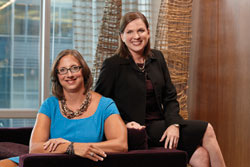Firms and attorneys foresee multiple benefits to supporting women's business goals

Jennifer Rakstad (left) and Joanna Horsnail work to retain female associates at Mayer Brown. Photo by Saverio Truglia.
Law firms and lawyers adopting Face-book COO Sheryl Sandberg’s philosophy—espoused in her Lean In book and Leanin.org’s Platform Partners project—see benefits for associates, clients and finances.
“Sandberg’s topics trickle into all areas, including law,” says Joanna Horsnail, a Chicago-based Mayer Brown partner and chair of its women’s leadership committee, which implemented a lean-in program for its fourth- and fifth-year associates. “We’re looking at the successful retention of female associates,” says Horsnail, who estimates Mayer Brown’s percentage of female income and equity partners at 16 percent. Nationally, female equity partnership averages at 15 percent, according to a 2012 National Association of Women Lawyers survey.
Sandberg’s goal in writing Lean In was to help women confidently pursue their business goals. For law firms, that means female lawyers may ride Sandberg’s leadership wave toward equity, and firms can save money.
“Attrition is expensive,” Horsnail says. “Attorneys making it through the first five years are running cases and doing hard-core case work; that’s a valuable segment. The cost of implementing lean-in groups is relatively nothing by comparison of what can be gained by firms retaining attorneys.”
BETTER BUSINESS
Linda K. Myers, who serves on the Kirkland & Ellis global management committee, says leaning in also supports client needs. “Lean-in partnering is also natural for client development,” says the Chicago-based debt finance practice partner. “Firms have increasing client pressure to deliver more diverse staffing on their matters.”
According to Kirkland’s management, women account for 23 percent of firm partners, both equity and nonequity.
Myers says the book provides “a framework for timely conversation and ideas for how to apply it within our existing gender initiatives. … I’ve even been in meetings where male colleagues are referring to the book.”
“Our groups meet by videoconference, so all our offices and practice groups participate,” says Mayer Brown’s career development attorney, Jennifer Rakstad, who serves as facilitator. “Each group wanted to pick a different chapter of the book. For example, one group chose career progression; another group with many parents chose work-life issues, such as how to off-ramp to a maternity leave and then come back on.”
Myers participated in a professional women’s lean-in discussion circle. “It was terrific intelligence to receive—and to give—about what each of us is trying to do within our own organizations,” she says.
For associates to be comfortable sharing thoughts, “everyone must agree to confidentiality,” Rakstad says. “We talked through the guidelines. If people don’t feel like they can be open, they aren’t going to say anything.”
Feedback is important, and Rakstad, based in Chicago, checks in after meetings. “One participant said, ‘This was the most candid forum we’ve gotten from the firm,’ ” she says.
From Kansas to Massachusetts to Oregon, women’s bar associations are also experimenting.
“A moderator and three-panel-member discussion was the format we used,” says Pam Berman, immediate-past president of the National Conference of Women’s Bar Associations, about an event the Women’s Bar Association of Massachusetts co-sponsored. “Questions from the Lean In website materials were given to the panelists just as guidelines.”
Berman recommends focusing on Gen X and Gen Y concerns.
“Co-parenting career strategies was one topic inspiring attendee discussions at the reception following our event,” she says. “The reception lasted two hours, though we anticipated 30 minutes. … Something about this is bringing people together.”
“This helps all the lawyers,” Horsnail says. “I see men also sharing family responsibilities. Putting supports in place, empowering associates to be successful—understanding that they have to take initiative over their own careers—benefits everyone.”
This article originally appeared in the November 2013 issue of the ABA Journal with this headline: “Lawyers Leaning In: Firms and attorneys foresee multiple benefits.”



